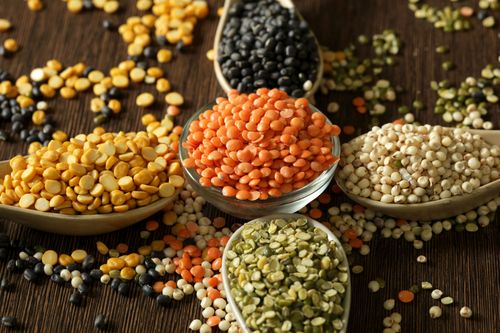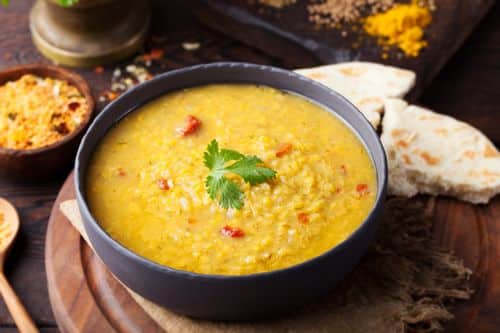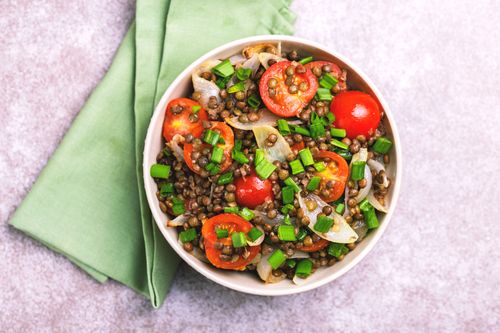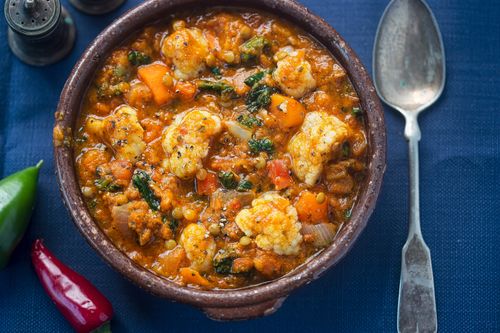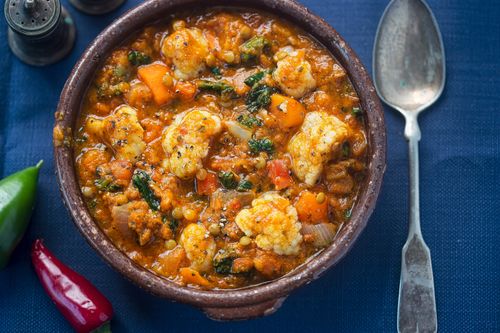
Summary: Lentils are edible seeds from the pulses group. Available with or without their outer shells, lentils are a staple food in many parts of Asia and North Africa. Here’s all you need to know about lentils, their nutritional values, benefits, and how to use them in your cooking.
Introduction
Lentils are one of the earliest cultivated legumes, so it is no wonder that they have become an essential part of our diet. They add a high volume of fiber and protein to our meals. They do not require soaking overnight before you cook them. Lentils are extremely handy and low-priced, and this makes them a widely selected form of high-quality protein.
Lentils are frequently characterized by color, which can vary from red, green, yellow, brown to black. Each kind of lentil is exclusively composed of phytochemicals and antioxidants.
Nutritional facts of lentils
Lentils’ nutritional values are often neglected. They are indeed rich in vitamin B complex, zinc, potassium, and magnesium. Lentils contain about 25% protein, which makes them an outstanding meat substitute. They are a rich source of iron, a mineral that is often missing in vegetarian regimes.
About one cup (198 grams) of cooked lentils generally provides:
- Calories: 230
- Carbohydrates: 39.9 grams
- Protein: 17.9 grams
- Fiber: 15.6 grams
- Fat: 0.8 grams
- Folate: 90% of the Reference Daily Intake (RDI)
- Manganese: 49% of the RDI
- Iron: 37% of the RDI
- Phosphorous: 36% of the RDI
- Copper: 25% of the RDI
- Thiamine: 22% of the RDI
- Potassium: 21% of the RDI
- Vitamin B6: 18% of the RDI
- Magnesium: 18% of the RDI
- Zinc: 17% of the RDI
- Pantothenic acid: 13% of the RDI
- Niacin: 10% of the RDI
Health benefits of lentils
1. Digestive and gut health
Fiber acts as a bulking agent in the digestive system as well as creates a feeling of fullness. Lentils are loaded with fiber, which helps in easy bowel movements and weight loss. Insoluble dietary fiber found in them helps prevent constipation and other digestive disorders like irritable bowel syndrome and diverticulosis.
2. Antioxidant properties
Lentils are filled with the goodness of polyphenols. These are a group of health-contributing phytochemicals. The polyphenols, like flavonoids along with other bioactive compounds, have strong anti-inflammatory, antioxidant and neuroprotective properties.
3. Stabilised blood sugar levels
The fiber found in lentils slows down digestion and helps in maintaining blood sugar levels. Including them frequently in your diet can help control blood sugar levels in diabetes, hypoglycemia, as well as insulin resistance, which was commonly seen in PCOS.
4. Healthy heart
Your overall risk of heart disease is greatly reduced if you consume lentils regularly because they are known for reducing blood pressure. Besides, proteins in lentils interfere with the chemical angiotensin i-converting enzyme (ACE), which usually causes blood vessel-narrowing and a rise in your BP.
Lentils being rich in folate, prevent excessive accumulation of homocysteine (a common amino acid in our blood). You are at a higher risk of heart disease if you are obese. They are also very filling, so you eat less food and stabilize your blood sugar levels.
5. Great protein source
Since lentils contain about 25% of protein, they become an excellent source of protein for vegetarians and vegans. While it contains all the essential amino acids, it is limited in methionine and tryptophan. Combining them with whole grains provides a complete profile of essential amino acids.
Caution: There is a downside to eating lentils in excessive amounts. They contain lectin, tannins, phytic acid, and trypsin inhibitors which may hamper absorption of important nutrients. The good news is that you can decrease the amount of these agents in your diet. Just soak the lentils the night before and discard the water used for soaking to get rid of the anti-nutrients.
Healthy Indian lentil recipes
#1 Masoor dal tadka
Masoor ki dal (red lentils) contains loads of protein.
| Nutritional Facts (Amount per serving) |
| Calories | 247 |
| Total Fat | 12 g |
| Saturated Fat | 7 g |
| Polyunsaturated Fat | 1 g |
| Monounsaturated Fat | 4 g |
| Cholesterol | 28 mg |
| Sodium | 492 mg |
| Potassium | 846 mg |
| Total Carbohydrate | 44 g |
| Dietary Fiber | 20 g |
| Sugar | 4 g |
| Protein | 17 g |
Ingredients – Serving 1
- Masoor ki dal – 1 cup
- Finely chopped tomatoes – 1 cup
- Finely chopped medium-sized onion – 1 cup
- Ginger garlic paste – 1 tsp
- A pinch of turmeric
- Dhania powder – 1/4 tsp
- Red chili powder – ½ tsp
- Garam masala – 1/4 tsp
- A pinch of hing
- Cumin seeds – ¼ tsp
- Deseeded red chili – 1-2
- Ghee – 1 tbsp
- Freshly chopped coriander leaves for garnishing
- Salt according to your taste
Procedure:
- Wash the lentils thoroughly and soak for 15 minutes. Add the lentils, 1/2 tsp salt, pinch of turmeric, 500ml water in a pressure cooker, and wait for 3-4 whistles.
- In a wok, heat oil. Then, add heeng and cumin. Saute chopped onions till golden-brown. Then, add ginger, garlic paste, remaining spices, chopped tomatoes, and cook till the oil leaves the mixture.
- Transfer the boiled dal into the wok and mix well. Pour the dal into a serving container.
- Temper with ghee, dry red chillies, and jeera. Pour it over the dal.
- Use coriander leaves for garnishing.
#2 Assorted Greens Salad with Lentils
A refreshing salad for a quick, yummy, yet healthy snack.
| Nutritional Facts (Amount per serving) |
| Calories | 99 |
| Total Fat | 13.2 g |
| Saturated Fat | 3.5 g |
| Cholesterol | 12.5 mg |
| Sodium | 115.4 mg |
| Total Carbohydrate | 27.7 g |
| Dietary Fiber | 14 g |
| Sugar | 21.8 g |
| Protein | 12.7 g |
Ingredients – Serving 1
- 1 cup mixed salad (tomato, cucumber, lettuce, and other greens)
- ½ cup lentils cooked
- 1 deseeded, sliced apple
- 1 tbsp feta cheese crushed
- 2 tbsp olive oil
- 1 tbsp red wine vinegar
Procedure:
- Add greens, about half the apple slices, and the feta to lentils.
- Drizzle the vinegar and olive oil over the salad.
- Serve the salad with the remaining apple slices as the side.
#3 Cauliflower-Lentil curry
A heart-healthy, gluten-free curry.
| Nutritional Facts (Amount per serving) |
| Calories | 177 |
| Total Fat | 4.8 g |
| Saturated Fat | 0.5 g |
| Total Carbohydrate | 27.5 g |
| Dietary Fiber | 9.6 g |
| Sugar | 7.2 g |
| Protein | 9.7 g |
Ingredients – Serving 1
- ½ cup rinsed lentils
- 1 chopped onion (small)
- 2 tsp curry powder
- ¼ tsp turmeric
- Salt (As per your taste)
- 4 deseeded and chopped ripe tomatoes
- 4 cups cauliflower florets
- 1 tsp sunflower oil
- 1 tsp cumin
- 3-4 garlic cloves, crushed
- 2 tsps ginger, fresh and crushed
- Freshly chopped coriander leaves
- 1 tsp brown sugar
- 2 tbsps lemon juice
- ¼ tsp pepper
- 1 jalapeno pepper, halved
Procedure:
- Add lentils, curry powder, salt, turmeric, sauteed onions to a pan, and cook over low heat for about 45 minutes.
- After the lentils are mushy and the consistency of the sauce is thick, add tomatoes, cauliflower florets, and jalapeno peppers. Cook till the cauliflower becomes soft.
- Take another frying pan and add cumin, ginger, and garlic and stir till the garlic turns golden.
- Stir in the pepper and add oil-spice mix to the pan with cauliflower mixture.
- Mix lemon juice, brown sugar, and coriander. Serve with plain, steamed rice.
Conclusion
It is difficult to imagine our Indian cuisine without the mighty lentils. Brown, green, yellow, red, or black — lentils are low in calories, rich in iron and folate, and excellent to taste. Lentils are packed with vitamins, magnesium, zinc, iron, and potassium.
References:
- Healthline.com
- Findanyanswer.com
- Eatingwell.com – mixed greens with lentils and sliced apple
- Eatingwell.com – cauliflower and red lentil curry
Frequently Asked Questions (FAQs)
A. They cook faster than beans or peas due to their smaller size. They do not need soaking overnight before you cook them. Lentils are readily available and low-priced, making them a highly preferred form of protein.
A. Lentils have anti-nutrients that can interfere with the absorption of other nutrients. You must soak the lentils before cooking and discard the water used for soaking and washing. This step will help in reducing these anti-nutrients.
A. Lentils are good for your heart health. They are rich in health-contributing nutrients that help in increasing HDL, lowering LDL, and controlling your blood pressure.
A. Lentils are rich in fiber, so they help in regular gut movements and development of healthy gut bacteria. They control your appetite and stop you from overeating. This helps in weight management.

